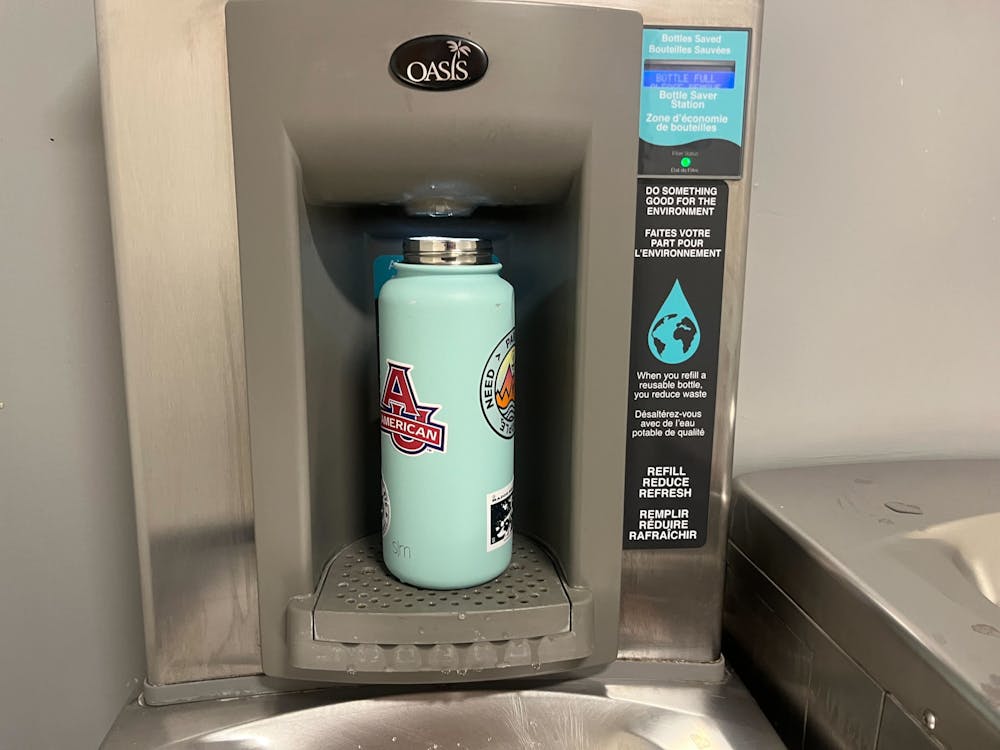Amid a growing interest in self-care and sustainability nationwide, reusable water bottles have taken the stage as a fun and easy way to stay hydrated in style.
“New York Times” estimates that more than $2 billion in reusable water bottles were sold in the United States in 2022, and this number has only increased over the past two years.
“Using a sustainable water bottle not only makes me use less plastic, but it keeps my water cold and accessible throughout the day,” said Maddie Wagner, a senior in the School of Public Affairs.
The American University community encourages the necessary move away from single-use plastic with multiple bottle refill stations around campus as part of the initiative to achieve zero waste by 2030.
But the question remains: which water bottle is best? The Eagle has you covered with this breakdown of some of the most popular bottles around campus and how they rank in terms of various categories.
Trendiness: Stanley FlowState Tumbler
The Stanley brand was founded by William Stanley in 1913 as the first vacuum-insulated steel container on the market.
After a feature in The Buy Guide in 2019, the FlowState tumbler accelerated in popularity and now doubles as a water bottle and internet-famous accessory.
With its sip-style structure (complete with two size options and a variety of accessory choices), a Stanley cup is perfect for long study days, workouts and days on the quad. The Stanley brand’s commitment to sustainability and quality should also not be overlooked.
Ethicality/Sustainability: Hydro Flask
Originating in the mountainous Pacific Northwest, Hydro Flask bottles exploded in 2019 amidst the VSCO frenzy, and have maintained steady prominence since then.
Besides creating a variety of water bottles and insulated container products, the company works to preserve U.S. national parks through its Parks for All campaign. The campaign has raised about $3.7 million to provide funding for park maintenance associations, including the nearby Anacostia Watershed Society.
A true surge in Hydro Flask popularity around AU’s campus occurred in October 2023, when the company stopped on the quad as part of their College Tour. They handed out complimentary branded stickers and held a game of ring toss with a free Travel Tumbler as a prize.
Since then, 32 oz bottles and their new Travel Tumblers have occupied the pockets of many backpacks and contribute to the push towards plastic-free life in a vibrantly practical way. In addition to practicality, Hydro Flasks are also built to last.
“I’ve been using Hydro Flasks since eighth grade and I enjoy the colors and quality,” Ariel Salas, a freshman in the Kogod School of Business, said.
Versatility: Owala FreeSip
The Owala FreeSip bottle is slowly but surely rising to the top, dotting tables at The Bridge and appearing in the side pockets of multiple students’ backpacks. Having made TIME Magazine’s 2023 Best Inventions list, Owala boasts an expansive selection of vibrantly-colored bottles that combine both a sip and straw lid in its newly patented technology.
As seen on TikTok, another pull towards Owala bottles is their visual appeal. Not only do they come in an array of vibrant colors, but, according to some users, they give the user the appearance of a koala when sipped through the straw.
A reviewer on Amazon says the Owala FreeSip is, “Perfect for everyday sipping or workout chugging… [It’s a] seriously genius idea.”
Affordability: Nalgene
Also sold at Target and Amazon, Nalgene bottles are a tried-and-true favorite.
Nalgene Co, founded in 1949, originated from the designs of leakproof plastic pipette jars used in chemistry labs and became popular within the camping industry in the 1970s.
The bottles, which range from 12 oz kids sizes to 32 oz, are a classic canvas for sticker collections and have an accompanying line of accessories to match. A 32 oz bottle typically sells for about $17 and is “lightweight, durable and easy to clean,” according to Isabell Otero, a freshman in The School of Public Affairs.
Reusable water bottles, no matter the type, are a great way to meet your hydration needs while keeping single-use plastics out of the environment. However, be sure to stick to one bottle for its entire lifespan to avoid overconsumption. Happy sipping!
This article was edited by Eliza DuBose, Sara Winick and Abigail Turner. Copy editing done by Luna Jinks, Julia Patton and Charlie Mennuti.





